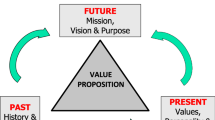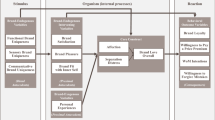Abstract
This article presents a study designed to investigate and map the trajectories of brand love. Consumers described experiences related to the initiation and evolution of their relationships with their most loved brand. Participants were asked to graphically trace the course of their feelings toward their currently most loved brand and to recall the events that influenced those feelings. The paths toward brand love followed five distinct trajectories, labeled as “slow development,” “liking becomes love,” “love all the way,” “bumpy road,” and “turnabout.” The formative experiences shaping these trajectories often include individual, personal, and private experiences that are largely outside any marketer’s control.

Similar content being viewed by others
References
Ahuvia, A. C. (1993). I love it! Towards a unifying theory of love across diverse love objects. Unpublished Ph.D. dissertation, Department of Marketing, Northwestern University, Evanston.
Ainsworth, M. D. S. (1985). Attachments across the life span. Bulletin of the New York Academy of Medicine, 61(9), 792–812.
Albert, N., Merunka, D., & Valette-Florence, P. (2008). When consumers love their brands: Exploring the concept and its dimensions. Journal of Business Research, 61(10), 1062–1075.
Alea, N., & Bluck, S. (2007). I’ll keep you in mind: The intimacy function of autobiographical memory. Applied Cognitive Psychology, 21(8), 1091–1111.
Alea, N., & Vick, S. C. (2010). The first sight of love: Relationship-defining memories and marital satisfaction across adulthood. Memory, 18(7), 730–742.
Aron, A., & Aron, E. N. (1986). Love and the expansion of self: Understanding attraction and satisfaction. Washington, DC: Hemisphere.
Barelds, D. P. H., & Barelds-Dijkstra, P. (2007). Love at first sight or friends first? Ties among partner personality trait similarity, relationship onset, relationship quality, and love. Journal of Social and Personal Relationships, 24(4), 479–496.
Batra, R., Ahuvia, A., & Bagozzi, R. P. (2012). Brand love. Journal of Marketing, 76(2), 1–16.
Baumgartner, H., Sujan, M., & Bettman, J. R. (1992). Autobiographical memories, affect, and consumer information processing. Journal of Consumer Psychology, 1(1), 53–82.
Baxter, L. A., & Bullis, C. (1986). Turning points in developing romantic relationships. Human Communication Research, 12(4), 469–493.
Bergkvist, L., & Bech-Larsen, T. (2010). Two studies of consequences and actionable antecedents of brand love. Journal of Brand Management, 17(7), 504–518.
Berscheid, E. (1983). Emotion. In H. H. Kelley, E. Berscheid, A. Christensen, J. H. Harvey, T. L. Huston, G. Levinger, E. McClintock, L. A. Peplau, & D. R. Peterson (Eds.), Close relationships (pp. 110–168). New York: Freeman.
Berscheid, E. (2010). Love in the fourth dimension. Annual Review of Psychology, 61, 1–25.
Bluck, S., Alea, N., Habermas, T., & Rubin, D. C. (2005). A TALE of three functions: The self-reported uses of autobiographical memory. Social Cognition, 23(1), 91–117.
Bodenhausen, G. V. (1993). Emotions, arousal, and stereotypic judgements: A heuristic model of affect and stereotyping. In D. M. Mackie & D. L. Hamilton (Eds.), Affect, cognition, and stereotyping: Interactive processes in group perception (pp. 13–37). San Diego: Academic.
Bowlby, J. (1960). Separation anxiety: A critical review of the literature. Journal of Child Psychology and Psychiatry, 1(4), 251–269.
Braun-LaTour, K. A., LaTour, M. S., & Zinkhan, G. M. (2007). Using childhood memories to gain insight into brand meaning. Journal of Marketing, 71(2), 45–60.
Chang, S.-C., & Chan, C.-N. (2007). Perceptions of commitment change during mate selection: The case of Taiwanese newlyweds. Journal of Social and Personal Relationships, 24(1), 55–68.
Dick, A., Chakravarti, D., & Biehal, G. (1990). Memory-based inferences during choice. Journal of Consumer Research, 17(1), 82–93.
Feldman, J. M., & Lynch, J. G. (1988). Self-generated validity and other effects of measurement on belief, attitude, intention, and behavior. Journal of Applied Psychology, 73(3), 421–435.
Fournier, S. (1998). Consumers and their brands: Developing relationship theory in consumer research. Journal of Consumer Research, 24(4), 343–373.
Hazan, C., & Shaver, P. (1987). Romantic love conceptualized as an attachment process. Journal of Personality and Social Psychology, 52(3), 511–524.
Huston, T. L., Surra, C. A., Fitzgerald, N. M., & Cate, R. M. (1981). From courtship to marriage: Mate selection as an interpersonal process. In S. Duck & R. Gilmour (Eds.), Personal relationships. Vol. 2: Developing personal relationships (pp. 53–88). London: Academic.
Jung, C. G. (1971). The collected works of C. G. Jung, volume 6: Psychological types. Princeton: Princeton University Press.
Kleine, S., Kleine, R. E., & Allen, C. T. (1995). How is a possession “me” or “not me”? Characterizing types and an antecedent of material possession attachment. Journal of Consumer Research, 22(4), 327–343.
Lastovicka, J. L., & Sirianni, N. J. (2011). Truly, madly, deeply: Consumers in the throes of material possession love. Journal of Consumer Research, 38(2), 323–342.
Latané, B. (1981). The psychology of social impact. American Psychologist, 36(4), 343–356.
Lott, B. E., & Lott, A. J. (1960). The formation of positive attitudes toward group members. Journal of Abnormal and Social Psychology, 61(2), 297–300.
Riela, S., Rodriguez, G., Aron, A., Xu, X., & Acevedo, B. P. (2010). Experiences of falling in love: Investigating culture, ethnicity, gender, and speed. Journal of Social and Personal Relationships, 27(4), 473–493.
Rossiter, J. R. (2011). Measurement for the social sciences: The C-OAR-SE method and why it must replace psychometrics. New York: Springer.
Rossiter, J. R. (2012). A new C-OAR-SE-based content-valid and predictively valid measure that distinguishes brand love from brand liking. Marketing Letters, 23(2), 905–916.
Rossiter, J. R., & Bellman, S. (2012). Emotional branding pays off: How brands meet share of requirements through bonding, companionship, and love. Journal of Advertising Research, 52(3), 291–296.
Schwarz, N. (2012). Feelings-as-information theory. In P. A. M. Van Lange, A. W. Kruglanski, & E. T. Higgins (Eds.), Handbook of theories of social psychology (Vol. 1, pp. 289–308). Thousand Oaks: Sage.
Schwarz, N., & Clore, G. L. (2007). Feelings and phenomenal experiences. In A. Kruglanski & E. T. Higgins (Eds.), Social psychology. Handbook of basic principles (2nd ed., pp. 385–407). New York: Guilford.
Shimp, T. A., & Madden, T. J. (1988). Consumer-object relations: A conceptual framework based analogously on Sternberg’s triangular theory of love. In M. J. Houston (Ed.), Advances in consumer research (Vol. 15, pp. 163–168). Provo: Association for Consumer Research.
Sternberg, R. J. (1986). A triangular theory of love. Psychological Review, 93(2), 119–135.
Sujan, M., Bettman, J. R., & Baumgartner, H. (1993). Influencing consumer judgments using autobiographical memories: A self-referencing perspective. Journal of Marketing Research, 30(4), 422–436.
Surra, C. A. (1985). Courtship types: Variations in interdependence between partners and social networks. Journal of Personality and Social Psychology, 49(2), 357–375.
Surra, C. A. (1987). Reasons for changes in commitment: Variations by courtship type. Journal of Social and Personal Relationships, 4(1), 17–33.
Walster, E. (1971). Passionate love. In B. I. Murstein (Ed.), Theories of attraction and love (pp. 85–99). New York: Springer.
Whang, Y.-O., Allen, J. A., Sahoury, N., & Zhang, H. (2004). Falling in love with a product: The structure of a romantic consumer-product relationship. In B. E. Kahn & M. F. Luce (Eds.), Advances in consumer research (Vol. 31, pp. 320–327). Valdosta: Association for Consumer Research.
Author information
Authors and Affiliations
Corresponding author
Rights and permissions
About this article
Cite this article
Langner, T., Bruns, D., Fischer, A. et al. Falling in love with brands: a dynamic analysis of the trajectories of brand love. Mark Lett 27, 15–26 (2016). https://doi.org/10.1007/s11002-014-9283-4
Published:
Issue Date:
DOI: https://doi.org/10.1007/s11002-014-9283-4




